Float Spa Hove offers a beautiful relaxation studio, providing the perfect space to practise yoga, Pilates, and mindfulness in a calm and supportive environment. Located in central Hove, our studio has quickly become a popular destination for those looking to enhance their wellbeing, whether through dynamic movement, deep relaxation, or stress relief.
Our expert-led classes are designed for all levels, with a focus on improving flexibility, strength, posture, and mental clarity. Whether you’re seeking a gentle, restorative practice, a challenging Vinyasa flow, or a relaxation session to de-stress, there’s something for everyone.
Pairing yoga and Pilates with floatation therapy and holistic treatments creates a complete wellness experience, supporting both body and mind. Join a class today and discover how regular practice can enhance your health, reduce stress, and improve overall relaxation.



The studio at Float Spa Hove is a calm, light-filled sanctuary designed to help you escape the stresses of daily life and immerse yourself in movement, breath, and mindfulness. Flooded with natural light and fresh air, the studio is tucked away from the noise of central Hove, allowing you to experience a deeper sense of peace and focus during your practice.
Led by highly experienced teachers, our yoga, Pilates, and relaxation classes cater to all levels, whether you’re looking to build strength, improve flexibility, reduce stress, or enhance overall wellbeing. From dynamic Vinyasa flows to restorative Yin yoga, energising Pilates, and soothing sound baths, there’s a class for everyone.
✔ Peaceful, welcoming atmosphere – A hidden oasis away from the hustle and bustle
✔ Expert instructors – Guidance from some of Brighton & Hove’s most experienced teachers
✔ Flexible class options – Drop-in, multi-class passes, and unlimited memberships available
✔ Holistic approach to wellness – Combine classes with floatation therapy, massage, and infrared sauna for ultimate relaxation
�
�
Take advantage of our Unlimited Yoga for 30 Daysoffer and experience the transformational benefits of regular practice. Whether you’re new to yoga or a seasoned practitioner, this is the perfect way to explore different classes and find what works best for you.
Our classes cover what you’d expect plus an eclectic mix of variations. New to Yoga? If you have never tried Yoga before, it’s a good idea to attend one of our beginners classes. These classes give you the basics you need to get started with your yoga practice. Give us a call on 01273 933680 for more details.
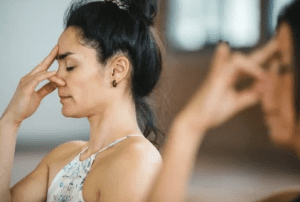
Breathwork is the practice of intentionally controlling your breath through specific techniques designed to regulate the autonomic nervous system. By engaging in structured breathing exercises, you can enhance relaxation, boost energy, and create balance within the body and mind—supporting both physical health and emotional wellbeing.
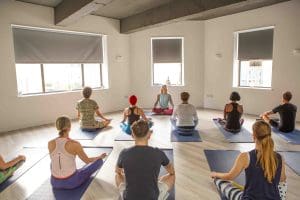
A deeply calming practice focused on gently opening the joints while cultivating mental clarity. This slow, intentional class offers a peaceful yet powerful journey into flexibility, mobility, and mindfulness—perfect for those seeking relaxation without vigorous movement. Gentle Hatha Yoga classes are also available at Float Spa Hove.
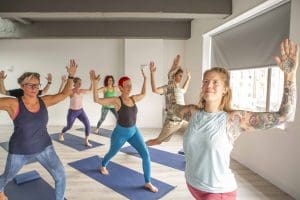
Kundalini Yoga, known as the “Yoga of Awareness,” is a dynamic and transformative practice that combines breathwork, movement, meditation, and mantra to awaken the creative energy within. This holistic approach promotes mental clarity, emotional balance, and deep spiritual connection, helping to unlock your full potential.
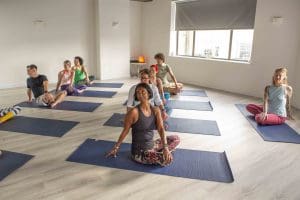
Pilates is a low-impact, core-focused practice that strengthens and stabilises the body through controlled movements, breathwork, and precision. Combining flexibility, balance, and strength, Pilates enhances posture, improves mobility, and builds a strong, resilient body while promoting mindful movement and overall wellbeing.
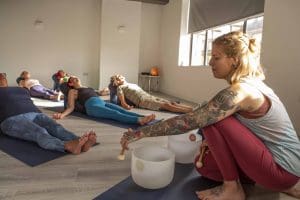
A sound bath is a deeply immersive experience where the frequencies, rhythms, and vibrations of instruments such as gongs, chimes, drums, and singing bowls create a meditative journey. This therapeutic practice promotes deep relaxation, reduces stress, and restores balance to the mind and body.
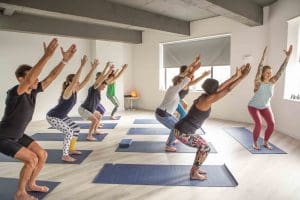
Vinyasa Flow is a dynamic yoga practice that seamlessly links breath with movement, guiding you through a series of fluid, dance-like poses. This energising and meditative flow enhances strength, flexibility, and mindfulness, creating a harmonious balance between body and breath.
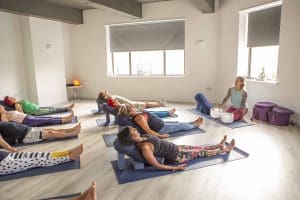
Yin Yoga is a slow, meditative practice focusing on floor-based postures held for extended periods to gently target the body's deep connective tissues, including fascia and ligaments. This mindful approach promotes flexibility, joint mobility, and inner stillness, creating a perfect balance to more dynamic forms of movement.
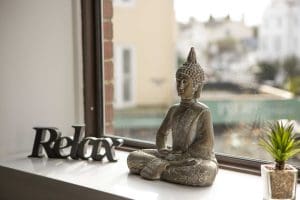
Yoga Nidra, often called ‘yogic sleep,’ is a deeply restorative meditation practice that guides you into a state of profound relaxation while remaining conscious. Regular practice can help reduce anxiety and depression, improve sleep quality, and support overall mental and physical wellbeing, leaving you feeling refreshed and rejuvenated.
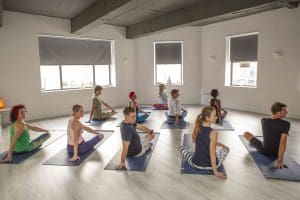
Yin Yang Yoga blends opposing elements to create a harmonious balance between strength and flexibility, movement and stillness, effort and surrender. This dynamic yet grounding practice combines flowing sequences with deep, held postures—leaving you feeling both energised and deeply relaxed in the same class.




A Yoga class at The Float Spa may not be the gentle activity many think it may be (some Gentle Classes are). It can be very aerobic and you can get hot. If the class has dynamic, ashtanga, or flow in its name, you may sweat. We’d recommend sports-style clothing – leggings, shorts, tracksuit bottoms, vests, fitted t-shirts. Please try to avoid jeans and clothing without any stretch. Leggings or fitted shorts are really helpful for the teacher to be able to see that your body has the correct alignment.
We don’t wear socks in a yoga class as they could be slippy and we want to take care of you.
The Float Spa provides all equipment including blankets as during the cool down time, you may get a tad chilly, so bringing a jumper may be preferred.
At The Float Spa we provide all yoga equipment including yoga mats for you to use in our classes. We keep the mats clean but you might want to bring a towel to put on top of the mat.
Equipment includes mats, bolsters, blocks, bricks, pillows, straps and blankets – do not worry if you do not know what equipment you will need for the classes, our expert yoga instructors are on hand to advise and make recommendations for you.
During a class, you may be handed a prop which your teacher will show you how to use, to help with certain postures.
This is most often a personal choice and the most common question we are asked at The Float Spa. Sometimes it will take trying out several yoga classes to see if they work for you. That’s a major benefit of having such a wide variety of classes 7 days per week.
If you are a beginner, it may be best to start at a beginners class or a class that says it is suitable for beginners. We also run a regular 6 week beginners course which may be of interest. Our front of house team are always around to help and advise, most of them can be seen joining in the yoga classes themselves so very happy to offer any recommendations based on your requirements.
If you have an illness please consult the front of house team prior to starting any yoga class at The Float Spa. We would recommend a class which is the most suitable for you, maybe a restorative, yin or one-to-one yoga. Doctors refer many clients to us. Common ailments can be helped by yoga particularly back problems, insomnia, sports injuries and post surgery rehabilitation.
Physical disabilities actually have the power to be our greatest teacher! They create a deeper awareness of the body and its mechanisms. Please tell the teacher about anything that may affect your practice so that they can offer you alternative postures or give you props to help you.�
Never!!!�
You are never too old to do yoga!
Beginner’s classes or a gentle yoga class are completely inclusive but you may also like to try a yoga classes specifically for the more senior members of our community.
Many yoga teachers will use touch to bring your attention to a specific part of your body and employ gentle adjustment techniques. If you don’t want to be touched, don’t be shy. We completely understand, we have cards in the studio for you to choose what is comfortable for you.
Yes! You are a perfect candidate for yoga. Many people think that they need to be flexible to begin yoga, but that’s a little bit like thinking that you need to be able to play tennis in order to take tennis lessons. Come as you are and you will find that yoga practice will help you become more flexible.
This newfound agility will be balanced by strength, coordination, and enhanced cardiovascular health, as well as a sense of physical confidence and overall well-being.
Yoga is amazing—even if you only practice for one hour a week, you will experience the benefits of the yoga. If you can do more than that, you will certainly experience more benefits. At The Float Spa we’d suggest starting with two or three times a week, for an hour or an hour and a half each time.
If you can only do 20 minutes per session, that’s fine too. Don’t let time constraints or unrealistic goals be an obstacle—do what you can and don’t worry about it. You will likely find that after a while your desire to practice expands naturally and you will find yourself doing more and more.
We have a range of pricing options available to suit everyone’s needs and also budgets.
The word yoga, from the Sanskrit word yuj means to yoke or bind and is often interpreted as “union” or a method of discipline. A male who practices yoga is called a yogi, a female practitioner, a yogini.
The Indian sage Patanjali is believed to have collated the practice of yoga into the Yoga Sutra an estimated 2,000 years ago. The Sutra is a collection of 195 statements that serves as a philosophical guidebook for most of the yoga that is practiced today. It also outlines eight limbs of yoga: the yamas (restraints), niyamas (observances), asana (postures), pranayama (breathing), pratyahara (withdrawal of senses), dharana (concentration), dhyani (meditation), and samadhi (absorption). As we explore these eight limbs, we begin by refining our behavior in the outer world, and then we focus inwardly until we reach samadhi (liberation, enlightenment).
Try to avoid a heavy meal for at least two hours before a class. In yoga practice we twist from side to side, turn upside down, and bend forward and backward. If you have not fully digested your last meal, it will make itself known to you in ways that are not comfortable.
A light snack is ok but it does depend on the class – ashtanga, dynamic or vinyasa flow classes use a lot of energy so you do not want your energy resources used up by digesting food. You can bring a bottle of water in to the class which should be drunk a sip at a time, if needed. Do drink plenty of water after a class.
If you are a person with a fast-acting digestive system and are afraid you might get hungry or feel weak during yoga class, experiment with a light snack such as yogurt, a few nuts, or juice about 30 minutes to an hour before class.
Om is a mantra, or vibration, that is traditionally chanted at the beginning and end of yoga classes (not all of them). It is said to be the sound of the universe. What does that mean?
Somehow the ancient yogis knew what scientists today are telling us—that the entire universe is moving. Nothing is ever solid or still. Everything that exists pulsates, creating a rhythmic vibration that the ancient yogis acknowledged with the sound of Om. We may not always be aware of this sound in our daily lives, but we can hear it in the rustling of the autumn leaves, the waves on the shore, the inside of a seashell.
Chanting Om especially at the beginning of end of a class allows us to recognize our experience as a reflection of how the whole universe moves—the setting sun, the rising moon, the ebb and flow of the tides, the beating of our hearts. As we chant Om, it takes us for a ride on this universal movement, through our breath, our awareness, and our physical energy, and we begin to sense a bigger connection that is both uplifting and soothing.�
Some teachers choose to use some Sanskrit terms in their classes (a common one you may hear is Savasana – pronounced Sha –var – san-nah – which means “corpse pose”, a literal translation meaning to lie on your back. This pose is used at the end of the class. This is a time to really assimilate the benefits of the yoga class and at the same time give the body the rest it needs for healing processes to take place).
Not all yoga teachers use the Sanskrit names for postures and even if they do they will always explain the pose as well.�